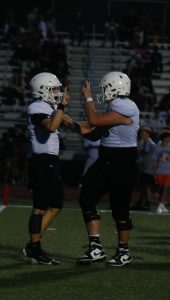Page 4: Uplifting stories of adversity are problematic
September 8, 2021
Headline after headline, one message remains consistent: no obstacle is ever impossible to surmount.
Adversity is uplifted as a core tenet of individual growth and resilience. But more often than not, it is emotional and physical overload that hinders people from reaching their full potential.
Star athlete and student, Madison Holleran committed to running cross country at the University of Pennsylvania, an elite Ivy League school renowned for its academic rigor and running teams.
Everyone saw Holleran as a perfect girl with a bright future. But the pressure of being perfect proved too much. She died by suicide after her first cross country season at Penn.
Her story is a disturbingly common example of adversity squashing talent. If Holleran’s mental and emotional needs were addressed in a healthy way, her talents could have been nurtured instead of diminished.
Harper Lee’s novel, “To Kill a Mockingbird,” is an excellent reflection of the harms of adversity.
Tom Robinson, a black man in a southern town, was accused of rape by a white woman. Because of his race, he was immediately seen as a guilty criminal.
No amount of individual willpower could have saved him. Tom Robinson faced a criminal justice system that didn’t care if he was innocent — it cared that he was black.
Adversity did not develop his character; adversity took his life from him.
Human beings revel in the stories of people, against all odds, overcoming adversity.
When adversity is excessively portrayed as something that is only positive, social institutions can rid themselves of the responsibility of ensuring that all human beings are provided basic resources that make it possible to overcome hardships in the first place.
Headline after headline, one message remains consistent: no obstacle is ever impossible to surmount. Adversity is uplifted as a core tenet of individual growth and resilience, but society overlooks the vast majority who have not overcome their hardships.
Not only are the stories of these people erased, but these same people are blamed for not surmounting impossible odds. Adversity, more often than not, is emotional and physical overload that hinders people from reaching their full potential.
From being a star student to star athlete, Madison Holleran had recently committed to running cross-country and track at the University of Pennsylvania, an elite Ivy League school renowned for its academic rigor and running teams.
Everyone saw Holleran as the epitome of a perfect girl with a bright future. But the pressure of being perfect proved too much. She died by suicide after her first cross country season at Penn.
Her story is a disturbingly common example of adversity squashing talent. If Holleran had been in more prosperous circumstances where her mental and emotional needs were addressed in a healthy way, her talents could have been nurtured instead of diminished.
There are also other pressures that arise from damaging stereotypes. From “all Asians are good at math” to “all Asians are doctors or engineers,” these seemingly positive and harmless stereotypes portray all people of Asian descent as hardworking, wealthy citizens that have overcome all adversity to achieve their status as the model minority.
However, these generalizations erase the diversity within the Asian community and the individual stories and struggles of millions of people are reduced to a faceless, invisible monolith. The narrative of the “model minority” is a lie that society likes to tell itself to justify blaming other people for not climbing their way out of the bottom. It’s a way of using Asian people as evidence that it is a moral failing to not succeed in America while still upholding the idea of the perpetual foreigner and denying Asian-Americans the legitimacy of being American.
Harper Lee’s novel, To Kill a Mockingbird, is also an excellent reflection of the harms of adversity.
Tom Robinson, a black man from the small southern town of Maycomb, was accused of rape by a white woman. But by having more melanin than the other folks in Maycomb, he was immediately seen as a guilty criminal.
There was no amount of individual willpower that could have saved him. Tom Robinson came face-to-face with a criminal justice system that didn’t care if he was innocent — it cared that he was black.
Adversity did not develop his character; adversity took his life from him.
Human beings revel in the stories of people, against all odds, overcoming adversity and becoming a stronger, more capable version of themselves.
But when adversity is excessively portrayed as something that is exclusively positive, institutions and social systems can absolve themselves of the responsibility of ensuring that all human beings are equipped with the basic resources that make it possible to overcome adversity in the first place.






